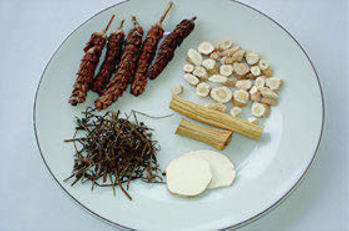When diagnosed and treated by a Chinese physician, patients will often be issued a list containing unfamiliar terms for medicines and foods. This list is known as a Chinese medicinal prescription or fang ji 
Fang ji  or simply called fang
or simply called fang  (which is short for yi fang
(which is short for yi fang  ), refers to the physician’s prescription; ji
), refers to the physician’s prescription; ji  , known as qi
, known as qi  in the ancient Chinese context, refers to making up a prescription or tiao ji
in the ancient Chinese context, refers to making up a prescription or tiao ji  . A fang ji
. A fang ji  is written after examining the cause of illness based on syndrome differentiation and the treatment method decided. Suitable medicines in appropriate dosage are chosen based on constitution principle, and observing appropriate herbal compatibility (peiwu
is written after examining the cause of illness based on syndrome differentiation and the treatment method decided. Suitable medicines in appropriate dosage are chosen based on constitution principle, and observing appropriate herbal compatibility (peiwu  ). Fang ji is one of the main tools used in treatment based on syndrome differentiation (bian zheng lun zhi
). Fang ji is one of the main tools used in treatment based on syndrome differentiation (bian zheng lun zhi  ).
).
The principles of composing herbal prescriptions 
The principles of composing herbal prescriptions  were first set out in the Internal Classic
were first set out in the Internal Classic  . During the Yuan Dynasty, Li Gao
. During the Yuan Dynasty, Li Gao  also mentioned these principles in The Theory of Spleen and Stomach
also mentioned these principles in The Theory of Spleen and Stomach  .
.
Monarch medicine (jun yao  ) refers to the medicine that provides the key remedy for the main illness. It has the strongest effect among all herbs in a prescription.
) refers to the medicine that provides the key remedy for the main illness. It has the strongest effect among all herbs in a prescription.
Minister medicine (chen yao  ) is an auxiliary medicine that serves to strengthen the curative effects of the monarch medicine on the main illness. It may also be used to treat accompanying illnesses or symptoms.
) is an auxiliary medicine that serves to strengthen the curative effects of the monarch medicine on the main illness. It may also be used to treat accompanying illnesses or symptoms.
Adjuvant medicines (zuo yao  ) come in three types. The first one is zuo zhu yao
) come in three types. The first one is zuo zhu yao  which works with monarch and minister medicines to enhance the curative effects and directly treat the secondary symptoms. The second kind of adjuvant medicine is zuo zhi yao
which works with monarch and minister medicines to enhance the curative effects and directly treat the secondary symptoms. The second kind of adjuvant medicine is zuo zhi yao  which removes or reduces the toxicity of monarch and minister medicines, restricting their stronger properties. The third one is fan zuo yao
which removes or reduces the toxicity of monarch and minister medicines, restricting their stronger properties. The third one is fan zuo yao  which directly opposes the taste properties of monarch and minister medicines, but complements them in terms of effects. Fan zuo yao also helps to prevent the body from becoming resistant to medicines. It is usually prescribed in small dosages.
which directly opposes the taste properties of monarch and minister medicines, but complements them in terms of effects. Fan zuo yao also helps to prevent the body from becoming resistant to medicines. It is usually prescribed in small dosages.
Dispatcher medicines (shi yao  ) come in two kinds. One is medicine for meridian guiding (yinjing yao
) come in two kinds. One is medicine for meridian guiding (yinjing yao  ) which directs other medicines to the area where the illness lies. The other is harmonising medicine (tiaohe yao
) which directs other medicines to the area where the illness lies. The other is harmonising medicine (tiaohe yao  ) which acts to harmonise the ingredients of a herbal prescription.
) which acts to harmonise the ingredients of a herbal prescription.

Fast facts
•The earliest fang shu  (medical formulary) was Prescriptions for Fifty-two Diseases
(medical formulary) was Prescriptions for Fifty-two Diseases  which was discovered in the Han tomb of Mawangdui at Changsha. It recorded 283 clinical prescriptions and also the earliest preparation form of ready-made medicines such as pills and powder.
which was discovered in the Han tomb of Mawangdui at Changsha. It recorded 283 clinical prescriptions and also the earliest preparation form of ready-made medicines such as pills and powder.
•During the Eastern Han Dynasty, Zhang Zhongjing  wrote Treatise on Febrile and Miscellaneous Diseases
wrote Treatise on Febrile and Miscellaneous Diseases  , held to be the ancestor of medical formulary
, held to be the ancestor of medical formulary  .
.
•The Ming Dynasty’s Prescriptions for Universal Relief  , which recorded 61,739 prescriptions, was known as the medical formulary with the most prescriptions.
, which recorded 61,739 prescriptions, was known as the medical formulary with the most prescriptions.

